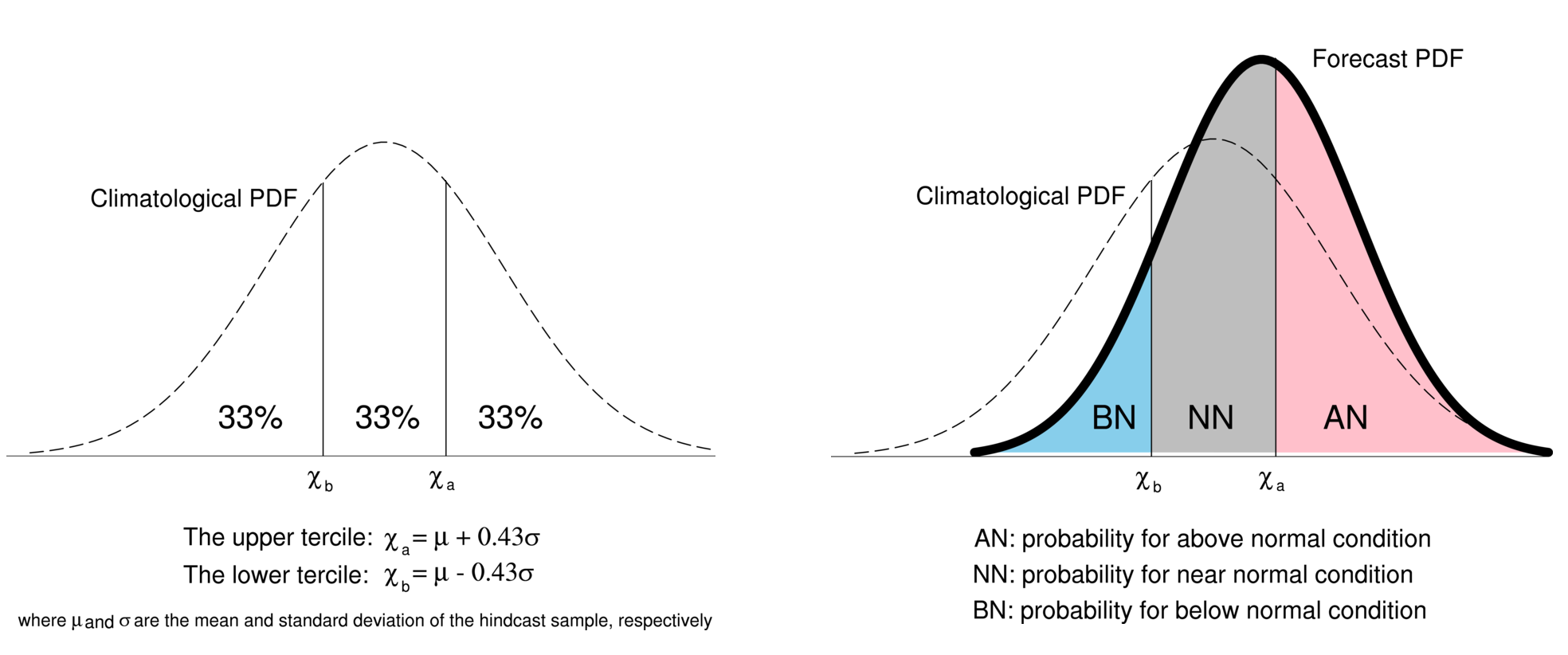APCC MME: Multi-Model Ensemble Forecast (High Resolution) Tutorial
The APCC seasonal forecast is based on multi-model ensemble (MME) prediction system and disseminated to APEC member economics around 15th of every month. Currently, 15 operational centers and research institutes from 11 countries around the world participate in the APCC MME operational prediction system by routinely providing their predictions in the form of ensembles of global forecast fields. The APCC's real-time operational forecasts are issued in both deterministic (based on ensemble mean) and probabilistic (based on full set of ensemble members) forms and more detailed description of the methods is as follows.
- Deterministic MME Forecast
The deterministic forecast is based on a simply average of bias-corrected ensemble means from each model with equal weight to create a multi-model forecast. The ensemble mean anomaly forecasts for each individual model is calculated by their own climatology from the hindcasts.
- Probabilistic MME Forecast
The probabilistic forecast is based on an uncalibrated MME with model weights being proportional to the square root of ensemble size, and a Gaussian fitting method for the estimation of the tercile-based categorical probabilities, that is, the probability of below-normal (BN), near-normal (NN), and above-normal (AN) categories with respect to climatology (Min et al. 2009). The procedure for the probabilistic forecast consists of following two steps.
- Estimate the individual model probabilities
The upper and lower terciles are determined separately for each model using their mean and standard deviation of hindcasts. Then, the forecast probability for each category is estimated as a portion of the cumulative probability of their forecast sample associated with the category.

- Multi-model combination
The forecast probabilities for each model are averaged together with model weights being inversely proportional to the random errors in the forecast probability associated with the standard error of the ensemble mean (i.e., proportional to the square root of ensemble size) to create a probabilistic multi-model ensemble forecast.

- Estimate the individual model probabilities
MME participating models
| Center/Institution | Country | System name |
|---|---|---|
| APCC | Korea | SCoPS |
| BCC | China | CSM1.1m |
| BoM | Australia | ACCESS-S2 |
| CMCC | Italy | SPS3.5 |
| CWA | Chinese Taipei | TCWA1Tv1.1 |
| ECCC | Canada | CANSIPSv3 |
| HMC | Russia | SL-AV |
| JMA | Japan | MRI-CPS3 |
| KMA | Korea | GloSea6GC3.2 |
| METFR | France | SYS9 |
| MGO | Russia | MGOAM2.4 |
| NASA | United States of America | GEOS-S2S-2.1 |
| NCEP | United States of America | CFSv2 |
| PKNU | Korea | CGCM v1.0 |
| PNU-RDA | Korea | CGCMv2.0 |
| UKMO | United Kingdom | GloSea6 |
List of parameters
| Name | Abbreviation for file name | Unit |
|---|---|---|
| Precipitation | prec | mm day-1 |
| Sea level pressure | slp | hPa |
| Sea surface temperature | sst | K |
| Temperature at 2m | t2m | K |
| Temperature at 850hPa | t850 | K |
| Zonal wind at 200hPa | u200 | m s-1 |
| Zonal wind at 850hPa | u850 | m s-1 |
| Meridional wind at 200hPa | v200 | m s-1 |
| Meridional wind at 850hPa | v850 | m s-1 |
| Geopotential height at 500hPa | z500 | m |
Temporal Coverage and resolution
Monthly and seasonal data up to 6 months lead time
*Lead time means the length of time between the issuance of a forecast and the occurrence of the phenomena that were predicted.
Spatial coverage and resolution
Global data whose resolution is 1°×1°
Data Format
NetCDF(CF-1.4)
References
- (Probabilistic Forecast) Min, Y.-M., V. N. Kryjov, C.K. Park, 2009: Probabilistic Multimodel Ensemble Approach to Seasonal Prediction. Weather and Forecasting, 24, 812-828
- (APCC MME Forecast) Min, Y. M., V. N. Kryjov, S. M. Oh, and H. J. Lee, 2017: Skill of real-time operational forecasts with the APCC multi-model ensemble prediction system during the period 2008-2015. Clim. Dyn., 49, 4141-4156
- (APCC MME Forecast) Min, Y. M., V. N. Kryjov, and S. M. Oh, 2014: Assessment of APCC multi-model ensemble prediction in seasonal climate forecasting: Restrospective (1983-2003) and real-time forecast (2008-2013). J. Geophys. Res., 119, 12, 132